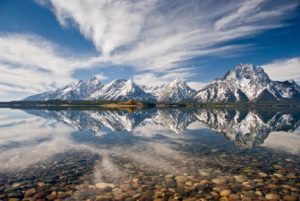
There is a thin line between the Tetons and their reflection that may someday change our lives. Image captured by GJH vice-president John Hebberger, Jr.
UNDERSTANDING OUR FAULT
The history of humanity is highlighted by astounding acts of bravery, charity, and sacrifice. We have created works of art, music and literature that live on through the ages. We have extended the frontiers of science beyond the imaginings of our ancestors and we construct enduring institutions around our best ideas and principles. But there is no such thing as a perfect human. No matter how beautiful or virtuous we may appear on the outside, secret faults, flaws, and cleavage planes hide beneath the skin of each of us, waiting to erupt in an explosion of fate when subjected to the right combination of heat and pressure. We are all capable of fracture and failure, and there is wisdom in the knowing of this. As Solzhenitsyn wrote, “…the line dividing good and evil cuts through the heart of every human being.”
There is a similar line that cuts through the heart of Teton County. We find in its existence a spectacle of beauty that sings to our souls in a language unreachable by mortal words. And yet for all the unspeakable beauty and majesty that is the Tetons, the fault that brought forth this jewel of creation from the depths of the earth holds sinister portent for all who live within its considerable reach. If we as a community fail to embrace this duality of good and evil resident beneath our feet, if we fail to regard our Teton fault as the wellspring of both beauty and disaster, the penalty will be greater on our day of reckoning.
And the fault will be ours. We already know enough about the Teton fault to know that we need to know a good deal more. It is a very young fault with displacement already exceeding 4 miles. Tilted volcanic features (with known ages) on both sides of the fault testify to the rapid and violent rise of the Teton Range and indicate that the majority of that motion took place within the last 5 million years. For that matter, there is strong evidence that the very first efforts to raise the Tetons are no more than 10 million years old. While 5 to 10 million years is a mere flash in the pan in geologic terms, it is not as discriminating as we would like when trying to predict what will happen tomorrow. The Teton fault has been silent for all of recorded Wyoming history, and geologists fear this hibernation could be our undoing. Notwithstanding the fact that it is the only unblemished line on the seismicity map of Western Wyoming, there is ample evidence that the Teton fault is capable of producing an earthquake strong enough to bring down many buildings and hillsides. But how often do these events befall the valley? How much movement can we expect between the valley floor and the mountains above the next time it all unzips? What clues exist in the landscape that might help us unravel these deeper mysteries?
One of the geologists looking for answers to these questions is Idaho State University geology Professor Glenn Thackray. His methodology is worthy of our notice. Carbon dating and other tools have tightly constrained the ages of some Teton glacial structures (mostly lateral and terminal moraines left behind during several recent glaciation episodes). These structures are most prolific where the glaciers poured out of the mountains and entered the valley – trespassing across the Teton fault in the process. Consequently, any evidence of fault motion scarring these glacial structures reflects seismicity that is the age of or younger than the structure itself. Measuring the extent of movement on these key moraine scarp locations thus gives a motion over time estimate that focuses on the last few thousand years rather than the last few million. Using the latest LiDAR imagery to locate faulting on the key glacial structures of young age, Professor Thackray’s findings write new chapters for those interested in recent Teton glaciation and those wondering if the Teton fault is dead. It is difficult to imagine a more relevant subject for GJH friends and members.
